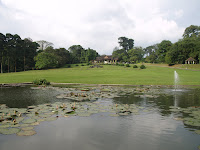

The center of the city is the Lapangan Merdea (Freedom square) with the National Monument, a 132 meters high column. Except of this, the center has some modern buildings and big streets.


The historic heart of Jakarta is in Kota, home to the remnants of the Dutch capital of Batavia. Along a channel (which smells very, very bad) can be seen many old Dutch colonial houses and also the Chicken Market Bridge.


The center of the Dutch town was on the Taman Fatahillah, the old town square, where the old City hall stands (built in 1710) and inside is now the Jakarta History Museum.


Close to the square is the Gereja Sion (Sion church), the oldest remaining church in Jakarta. It was built in 1695 for the "black Portuguese" brought to Batavia as slaves and given their freedom if they joined the Dutch Reformed Church. It's the only church we've seen with an organ inside.





Before coming to Jakarta, we made a stop in Bogor. In the center of this city is the Bogor's botanical gardens, called Kebun Raya. This "green lung" was first laid out by the British governor Sir Stamford Raffles and later expanded by Dutch botanists. The gardens are big and full of plants, many different palm trees, water plants, cactus, etc.


The historic heart of Jakarta is in Kota, home to the remnants of the Dutch capital of Batavia. Along a channel (which smells very, very bad) can be seen many old Dutch colonial houses and also the Chicken Market Bridge.


The center of the Dutch town was on the Taman Fatahillah, the old town square, where the old City hall stands (built in 1710) and inside is now the Jakarta History Museum.


Close to the square is the Gereja Sion (Sion church), the oldest remaining church in Jakarta. It was built in 1695 for the "black Portuguese" brought to Batavia as slaves and given their freedom if they joined the Dutch Reformed Church. It's the only church we've seen with an organ inside.





Before coming to Jakarta, we made a stop in Bogor. In the center of this city is the Bogor's botanical gardens, called Kebun Raya. This "green lung" was first laid out by the British governor Sir Stamford Raffles and later expanded by Dutch botanists. The gardens are big and full of plants, many different palm trees, water plants, cactus, etc.


No comments:
Post a Comment